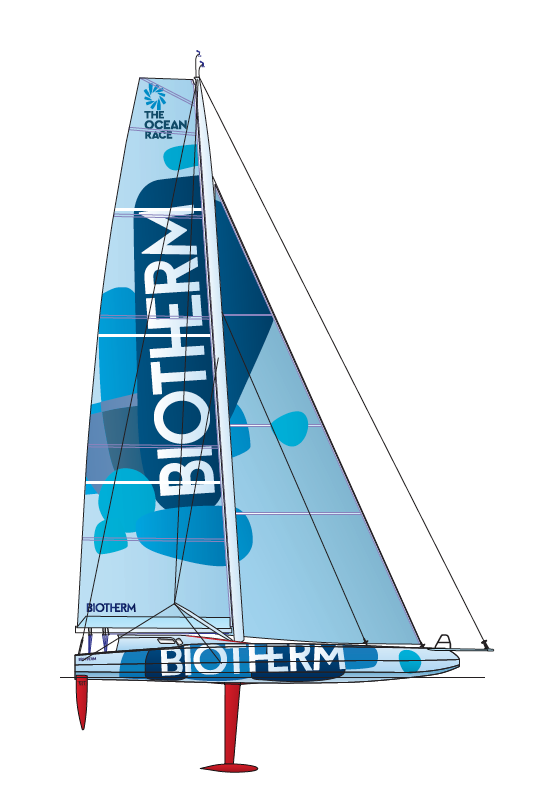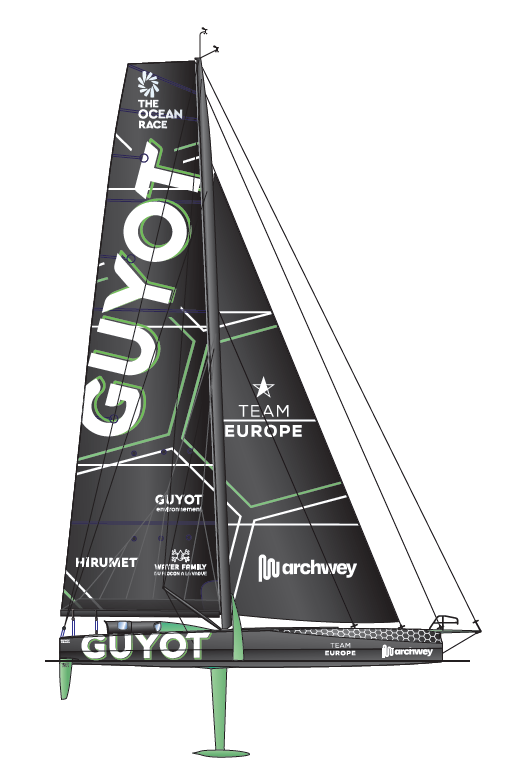PART THREEFROM VOLVO 65 to IMOCA, 2014-2023
Since I first started redesigning the hulls of the Volvo yachts, I have observed that the evolution of the shapes has always evolved between two editions. With the implementation of a one design for the 2014-15 Volvo Ocean Race, we could expect real improvements, given the diversity and quality of the ideas of the three previous Volvo designers, and especially given the progress of development on the Mini-Transat and IMOCA boats. The choice of the Volvo 65 one-design designer, Bruce Farr, in the wake of Groupama 4’s victory, has not failed to surprise. Indeed, for 2011-12, the Farr yacht design firm only designed Abu Dhabi, which came fifth, behind three yachts from the Juan Kouyoumdjian office, which had already taken first place in the two editions of 2005-06 and 2008-09.

HOLCIM
As early as December 2014, I had drawn the lines of this new Volvo in an attempt to grasp what this yacht had in store. The first thing that struck me was the size of her bulb, only 3.5 tons, close to the weight of those of the IMOCA 60s, while the VO 70s were tending towards double. The 20 centimeters of extra draft aren’t insignificant, but they don’t compensate for the stiffness of a 7-ton keel. IMOCA racing yachts are very light boats designed for offshore racing, they have 5000 liters of ballast for the breeze and a small bulb for the light air. The second surprise came when I searched for what the firm had learned from their previous design, Abu Dhabi. The design of this boat was quite radical, with a very curved bow, a wide waterline and a low bilge. The 65 retains vertical sides and a maximum forward beam, but has a very open V-shape from the middle of the hull.
Since her shapes are typical of TP 52s, I checked out the sections of Marcelino Botin’s boat, Camper, which finished second in 2012. Marcelino is well known for his accomplishments in this class, and the capacity of his craft to plane close-hauled in medium winds is remarkable. With a maximum beam very far aft, when heeled, the boat is on a virtually flat bottom for half its length, leaning on her bilge, she planes wonderfully.
By superimposing the sections of the Camper and the 65, I was surprised by the similarity of the shapes, certainly softer on the 65, with a bilge closer to the waterline, which makes the V even more open. However, this aperture doesn’t give her stiffness comparable to the one Groupama 4 had. Juan Kouyoumdjian’s hull had a natural stiffness, thanks to her full shape under the bilge, moving the center of buoyancy away from the heel. For her ability to start on the planning, she relied on her extremely stretched lines on the eight tenths of her length.
According to her specifications, the VO 65 lacks a little stiffness and sail area, which is not very good for performance. She will heel quick, and may well find a favorable wind angle, but if the wind increases, she may not be as fast as a 60', but she may be better suited to upwind sailing, and in any case, with a speed that may not be greater than that of her predecessors.
The race, which was becoming more and more difficult both in terms of the course and the scoring, with regattas in-port, is followed in France thanks to a stopover in Lorient and in Charles Caudrelier’s presence, skipper of the Chinese boat Dongfeng, which placed third behind Abu Dhabi Ocean Racing skippered by Ian Walker and Team Brunel.
In the thirteenth edition of the round-the-world race, the 2017-18 Volvo Ocean Race, the Volvo Ocean 65s are undergoing a refit and seven competitors are lining up at the start of Alicante. Dongfeng Race Team wins, with a Franco-Chinese crew skippered by Charles Caudrelier, and composed of Pascal Bidégorry, Franck Cammas, Jérémie Beyou, Justine Mettraux, Marie Riou and Kevin Escoffier.

Dongfeng Race Team
Five IMOCA teams are ready to race around the world in The Ocean Race 2023.
Guillaume Verdier’s latest design, Holcim-PRB, is typical of the latest trends in IMOCA boats, with marked indentations at three levels, the bottom, the main bilge and another, higher one. A bow that rebounds, with a waterline that begins at a tenth of the length of the boat, and ends with a bottom parallel to the waterline on the back tenth. A center of gravity far aft, a mainsail setback on the rear limit of the hull. A generous foil that allows you to stay in the air on all points of sail. We are very far from the shape of the VO 65, which dates from another era.
 |
| HOLCIM |
As early as December 2014, I had drawn the lines of this new Volvo in an attempt to grasp what this yacht had in store. The first thing that struck me was the size of her bulb, only 3.5 tons, close to the weight of those of the IMOCA 60s, while the VO 70s were tending towards double. The 20 centimeters of extra draft aren’t insignificant, but they don’t compensate for the stiffness of a 7-ton keel. IMOCA racing yachts are very light boats designed for offshore racing, they have 5000 liters of ballast for the breeze and a small bulb for the light air. The second surprise came when I searched for what the firm had learned from their previous design, Abu Dhabi. The design of this boat was quite radical, with a very curved bow, a wide waterline and a low bilge. The 65 retains vertical sides and a maximum forward beam, but has a very open V-shape from the middle of the hull.
According to her specifications, the VO 65 lacks a little stiffness and sail area, which is not very good for performance. She will heel quick, and may well find a favorable wind angle, but if the wind increases, s
The race, which was becoming more and more difficult both in terms of the course and the scoring, with regattas in-port, is followed in France thanks to a stopover in Lorient and in Charles Caudrelier’s presence, skipper of the Chinese boat Dongfeng, which placed third behind Abu Dhabi Ocean Racing skippered by Ian Walker and Team Brunel.
In the thirteenth edition of the round-the-world race, the 2017-18 Volvo Ocean Race, the Volvo Ocean 65s are undergoing a refit and seven competitors are lining up at the start of Alicante. Dongfeng Race Team wins, with a Franco-Chinese crew skippered by Charles Caudrelier, and composed of Pascal Bidégorry, Franck Cammas, Jérémie Beyou, Justine Mettraux, Marie Riou and Kevin Escoffier.
 |
| Dongfeng Race Team |
















